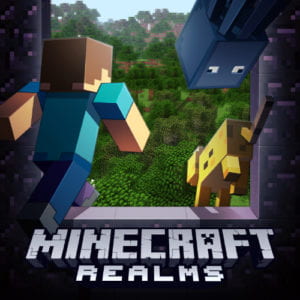Growing up in the country, I spent countless hours playing alone in the woods. Unbelievable worlds full of pirates, bandits, explorers and cowboys were constructed from the most basic of found materials. I was alone with my imagination in the production of a virtual world contained in the trees, rocks, gulleys and hideouts that the woods afforded me. Although my siblings might join in playing in close proximity to my own forts, they were often far removed in other parts of the wilderness where they were constructing their own lands for me to visit (or attack) later in the day. These experiences afforded me a rich imagination and access to natural materials as raw invitations to play and creativity. They were spaces of play which, by definition does not have a defined outcome. I wonder if the play of Minecraft Realms may be comparable?
In examining this modality through a media critique I am eager to argue that it provides opportunities for: social growth, digital literacy, autonomy, community building, and collaborative problem solving. For learners in Primary school, these goals are all essential to a child’s understanding of self and their place in the world. These opportunities are also critical features of dramatic literacies which I work to investigate throughout my teaching practice. They are all skills idealized wilderness exploration offers and they can begin to be realized on a student’s iPad.

Found: https://media.mojang.com/83ebfcf578fafe2a1fd2b4027a0713a88e0287e0/fivehundredwide1.jpg
Minecraft Realms is a fascinating subset of the Minecraft phenomena. It offers players a space to privately create a world that only those who they give access can manipulate and play within. The safety its closed walls provide is attractive to me as an educator looking for an online medium because of student safety and accessibility. This digital temporality is fascinating in the possibilities it holds as players can virtually create an extravaganza of a world for their chosen collaborators to participate in. The unrestricted access to the materials of the game is also another advantage as an educator interested in creating online platforms because it is budget-conscious for the institution and thus equally accessible to students no matter their socio-economic status.
Throughout my investigations into media that might appear in my own teaching and learning, I am the most excited about Minecraft Realms because it opens the door to any number of provocations that might be posed in the classroom. I could invite students to create a medieval town with clearly delineated jobs and buildings (that they may have researched prior) and they would be able to develop a digital landscape for such a task. While elements of this play can take place in the classroom, the full realization of a virtual landscape with the extensive use of materials and collaborative construction offers a scale not previously available to young students. Meanwhile, they would also be learning how to work collaboratively, use specific materials in creative ways, develop their own positioning to the world they are constructing, and solve problems that might be posed by my own avatar in their world or others created by their peers.
The diversity this platform offers ranges from pure play to overly choreographed constructions and everything in-between. Each of these possibilities is exciting to me as an educator looking for a safe, virtual reality that encourages each student to step back and realize exactly what their place is in the world of their making. It’s a larger parallel to their lives that this platform specializes in. It’s also a critical life skill for all of our students as they navigate the complexities of the digital world. I hope it becomes a space that celebrates the same sense of adventure and accomplishment that kept me running to play in the woods for so many years of my young life.
I love that you chose to analyze Minecraft!
When I watched my French sister’s children playing it a few summers ago, my mind was completely blown by the package of interactive, creative tools at their disposal. They were learning about building materials and coordinating their own aesthetically pleasing environment. And as you pointed out, the socioeconomic status falls away when creating on a virtual platform.
Your idea to challenge children to create a medieval town sounds educational and fun. I wonder about the set design implications and the practical applications in the theatre world.
Personally, I don’t think a virtual game could ever replace time spent exploring nature, but perhaps there are populations like children with special needs who could use Minecraft to have experiences that would otherwise be inaccessible to them? As someone who holds firmly to the belief that movement facilitates learning in all situations, I look forward to the next version of Minecraft in which they will develop a full-body interactive model: Wii + Minecraft.
With Virtual Reality on its way to becoming a more ubiquitous gaming experience, I am hoping to see more applications like Hololens and Minecraft (seen here: https://youtu.be/xgakdcEzVwg?t=2m35s). I’m not sure if it exactly fits your bill for a “full-body interactive mode” – but it’s pretty darn cool. Especially since the person wearing the hololens can be the educator overlooking students or even a student overlooking their group acting as a foreman!